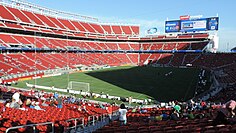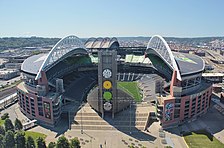
A | B | C | D | E | F | G | H | CH | I | J | K | L | M | N | O | P | Q | R | S | T | U | V | W | X | Y | Z | 0 | 1 | 2 | 3 | 4 | 5 | 6 | 7 | 8 | 9
| Centennial Cup America (English)[1] Copa América Centenário (Portuguese) | |
|---|---|
 | |
| Tournament details | |
| Host country | United States |
| Dates | June 3–26 |
| Teams | 16 (from 2 confederations) |
| Venue(s) | 10 (in 10 host cities) |
| Final positions | |
| Champions | |
| Runners-up | |
| Third place | |
| Fourth place | |
| Tournament statistics | |
| Matches played | 32 |
| Goals scored | 91 (2.84 per match) |
| Attendance | 1,483,855 (46,370 per match) |
| Top scorer(s) | |
| Best player(s) | |
| Best goalkeeper | |
| Fair play award | |
The Copa América Centenario (Portuguese: Copa América Centenário, French: Coupe Amerique Centennaire, English: Centennial Cup America;[2][3] literally Centennial America Cup) was an international men's soccer tournament that was hosted by the United States in 2016. The competition was a celebration of the centenary of CONMEBOL and the Copa América, and was the first Copa América hosted outside South America.[4]
The tournament was a commemorative version of Copa América (not the 45th edition). It was held as part of an agreement between CONMEBOL and CONCACAF as a special edition between the usual four-year cycle, and featured an expanded field of sixteen teams (an increase from the usual twelve), with all ten teams from CONMEBOL and six teams from CONCACAF. Despite the tournament being an official iteration of the Copa América, the winner would not receive an invitation to the 2017 FIFA Confederations Cup due to the commemorative nature of the tournament, although eventual winners Chile had already qualified through their 2015 victory.
Chile became the fourth nation to win at least two consecutive titles in CONMEBOL tournaments, after Uruguay, Argentina and Brazil. Argentina, meanwhile, lost their third consecutive final in a major tournament, following losses to Germany at the 2014 World Cup and Chile at the 2015 Copa América.
Planning
In February 2012, Alfredo Hawit, then Acting President of CONCACAF, announced that the competition would be expected to take place in 2016, as a celebration of CONMEBOL's centenary.[5] CONMEBOL President Nicolás Leoz said "Hopefully we can organize a big event, because we're 100 years old and we want to celebrate big."[6]
The tournament was announced by CONMEBOL on October 24, 2012[7] and confirmed by CONCACAF on May 1, 2014.[1]
On September 26, 2014, FIFA announced that the tournament had been added to the FIFA International Match Calendar, meaning that clubs had to release players called up to the competition.[8]
The tournament occurred in June 2016, along with UEFA Euro 2016.
Sports executive corruption
The tournament was placed in doubt after several high-profile sports executive arrests were made including people involved with media rights holder Datisa (using the trading name of "Wematch"), a partnership between three media rights companies; Full Play, Torneos and Traffic Sports Marketing. In December 2014, Brazilian José Hawilla, the owner and founder of Traffic Sports pled guilty to "corruption charges including racketeering, wire fraud and money laundering". In an indictment, the FBI stated that officials were to receive bribes totalling US$20million for the 2016 event.[9][10] Datisa held agreements for the commercial rights with CONMEBOL and CONCACAF and had their bank account frozen placing the tournament in jeopardy.[11] On October 21, 2015, CONCACAF announced that they had terminated their agreement with Datisa.[12]
On October 23, 2015, CONCACAF, CONMEBOL and the hosting association U.S. Soccer Federation all confirmed that the tournament was going ahead as originally intended.[13][14][15]
Trophy

A new trophy was supposed to be created for the tournament and was to be unveiled on July 4, 2015, at the 2015 Copa América final.[16] No trophy was unveiled amidst the FIFA corruption scandal.[citation needed] However, CONMEBOL announced that, on April 28, 2016, a presentation for the trophy would take place in Bogotá, Colombia.[17]
On April 28, 2016, it was explained on the Copa América website that the "new" trophy was in fact commemorative, and would only be given to the winning country to keep, while the original silver trophy would continue to be awarded to each winner of the tournament (including the 2016 winner). The Centenario trophy retains the silhouette of the original trophy's Grecian urn, but is plated in matte gold. The front of the trophy is adorned with a raised (and in the case of some parts of the logo, engraved) image of the Copa América Centenario wordmark and logo. On each side are raised and polished images of a connected North and South America, commemorating the first Copa América held outside South America. Instead of the traditional wooden base holding the names of all past winners, the base of the Centenario commemorative trophy includes 16 zones, in which the names of all 16 nations are engraved. Other details include: The logos of both CONMEBOL and CONCACAF (the two confederations with representatives in the tournament), the years "1916–2016" (commemorating the 100 years of CONMEBOL and Copa América), and the phrases "La Copa del Siglo" ("The Cup of the Century") and "Uniting the Americas".[18]
Host selection
Luis Chiriboga, the President of the Ecuadorian Football Federation stated the United States and Mexico were potential hosts of at least one stage of the competition.[19] Hawit preferred the competition to be hosted in the United States for financial reasons, stating that "the market is in the United States, the stadiums are in the United States, the people are in the United States. The study that we have made that everything’s in the United States."[20] In July 2012, CONCACAF President Jeffrey Webb stated there was much organizing to be done.[21]
On May 1, 2014, it was announced that the tournament would be held in the United States from June 3–26, 2016.[1][22][23]
The decision to select the U.S. as a host was the object of criticism by Uruguay Football Association president Wilmar Valdez on June 7, 2016, who complained that the U.S. is "a country where they don't feel football", which "brings about problems." The complaint was voiced after Uruguay's defeat against Mexico, in favor of whom, he said, the event was biased.[24] Just prior to the game itself, the Chilean anthem was mistakenly played instead of the Uruguayan anthem.[25]
Venues
On January 8, 2015, CONCACAF and CONMEBOL announced the 24 U.S. metropolitan areas which had indicated interest in hosting matches.[26][27]
The stadiums were chosen following a bidding process, with the minimum capacity to be 50,000. The final list of venues, anticipated to number between 8 and 13, was to be announced in May 2015. However, the list was not released and speculation regarding whether the tournament will be able to move forward arose because Interpol red notices were issued for the former presidents of the CONMEBOL and CONCACAF confederations in relation to the 2015 FIFA corruption case, including allegations that they accepted significant bribes in relation to the $112.5 million broadcasting deal for the event.[28] However, officials from CONMEBOL expressed a desire to move forward with the event despite the scandal.[29]
On November 19, 2015, the ten venues selected for the tournament were announced by CONCACAF, CONMEBOL, and U.S. Soccer Federation.[30][31][32]
| Pasadena, California (Los Angeles Area) |
East Rutherford, New Jersey (New York City Area) |
Houston, Texas | Philadelphia, Pennsylvania |
|---|---|---|---|
| Rose Bowl | MetLife Stadium | NRG Stadium | Lincoln Financial Field |
| Capacity: 92,542 | Capacity: 82,566 | Capacity: 71,000 | Capacity: 69,176 |

|

|

|

|
| Foxborough, Massachusetts (Boston Area) |
Location of the host cities of the Copa América Centenario. |
Santa Clara, California (San Francisco Bay Area) | |
| Gillette Stadium | Levi's Stadium | ||
| Capacity: 68,756 | Capacity: 68,500 | ||

|

| ||
| Seattle, Washington | Chicago, Illinois | Glendale, Arizona (Phoenix Area) |
Orlando, Florida |
| CenturyLink Field | Soldier Field | University of Phoenix Stadium | Camping World Stadium |
| Capacity: 67,000 | Capacity: 63,500 | Capacity: 63,400 | Capacity: 60,219 |

|

|

|

|
Participating teams
At the official announcement of the tournament, CONMEBOL and CONCACAF confirmed that all ten CONMEBOL members would be joined by six CONCACAF teams in the tournament. Among CONCACAF teams, the United States and Mexico automatically qualified.[33][34] The other four spots were given to Costa Rica, the champions of the Central American Football Union by winning the 2014 Copa Centroamericana, Jamaica, the champions of the Caribbean Football Union by winning the 2014 Caribbean Cup, and Haiti and Panama, the two play-off winners among the four highest finishers in the 2015 CONCACAF Gold Cup not already qualified.[35]
| CONMEBOL (10 teams) | CONCACAF (6 teams) |
|---|---|
Draw

The group seeds and match schedule were announced on December 17, 2015.[36] The United States (Group A) were seeded as host, while Argentina (Group D) were seeded as the highest FIFA-ranked team in the CONMEBOL region during December 2015. According to Soccer United Marketing, Brazil (Group B) and Mexico (Group C) were seeded as they were "the most decorated nations in the last 100 years in international competitions from their respective confederations".[37] However, there was criticism for not including Uruguay, which won two World Cups and was the Copa América all-time leader with 15 championships, or Chile, which were the defending Copa América champions going into the tournament.[38][39]
The draw took place on February 21, 2016, at 7:30 pm EST, at the Hammerstein Ballroom in New York City. Teams were seeded using the FIFA Ranking from December 2015.[40]
| Pot 1 | Pot 2 | Pot 3 | Pot 4 |
|---|---|---|---|
The four group pots contained four positions each,[41] one from each group, as follows:
| Pot 1 | A1 | B1 | C1 | D1 |
|---|---|---|---|---|
| Pot 2 | A2 | B2 | C2 | D2 |
| Pot 3 | A3 | B3 | C3 | D3 |
| Pot 4 | A4 | B4 | C4 | D4 |
Squads
Each country had a final squad of 23 players (three of whom had to be goalkeepers) which had to be submitted before the deadline of May 20, 2016.[42]
Match officials


